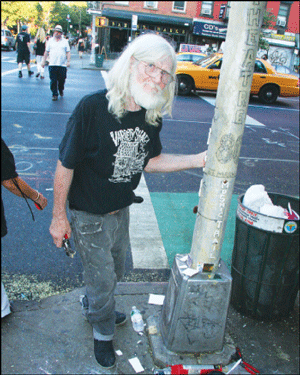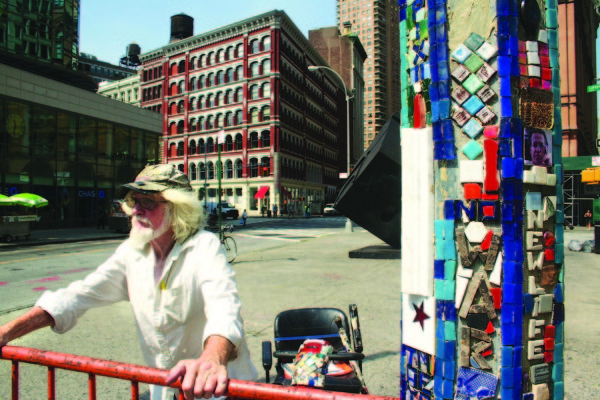
BY LINCOLN ANDERSON | Jim Power, the East Village’s Mosaic Man, says he’s being pushed to the limit, asked to do what may be humanly impossible. He has around four months left to restore seven of his iconic mosaic-encrusted street light poles, so that they can be returned to Astor Place in time for the completion of the Astor Place / Cooper Square renovation project this summer. But he said he needs more funds to do the job properly — plus, it should actually include 10 of his poles, not seven.
Currently, the poles are sitting in a city Department of Transportation lot in Sunnyside, Queens. That’s another issue for Power, who has limited mobility. The Mosaic Man, who lives in supportive housing at The Lee, on E. Houston St., is hoping to find someplace nearby him where he can fix up the lampposts. He had hoped the Lower Eastside Girls Club on Avenue D might be a possibility.
The Village Alliance business improvement district has agreed to give Power up to $9,000 for the work, paying him on a pole-by-pole basis as he completes each one.
But Power contends he needs $40,000 to do the work properly, which would include 10 poles, including $3,000 for a couple of assistants to help him.
The poles, he explained, are not going back to the East Village as mere street furniture, but as “sculptures.”
“This is a really unusual trip — it’s never been done,” he said of the novel project.
He is considering doing a Kickstarter campaign to raise the additional cash, though is currently “on strike” through April 1, he said, over his frustration with the project.
The poles were removed from Astor Place and cut down to 10 feet tall. The mosaics stop at 8 feet high, leaving the poles’ top 2 feet barren. Power plans to cover up these unadorned areas with brickettes — bricks or slabs that are about one-twelfth the thickness of normal bricks — on top of which he will have added mosaics. Then, eight of these small, 3-inch-wide brickettes will be glued to the tops of each of the octagonal poles.
Topping it all off, literally, Power hopes that a local potter from E. Ninth St. will then create blue-and-green “crowns” to perch atop each of the posts.
All the lampposts will need new grouting, which is a major job in itself, but Power has a special tool for that.
Though he is on strike, Power is raring to get to work.
“My time is precious and they’re wasting my time,” he said, adding, “Forget their plan — I’m doing my plan.”

A master craftsman, he refuses to skimp on materials or do a shoddy job.
“This is going to be out there for the next 1,000 years,” he said of the totemic “Mosaic Trail” posts. “We’re going to build this the way the Irishman started this — or we’re not going to build it at all,” he declared, referring to himself.
“A patch job, this ain’t. This is historical restoration. I’ll raise the money myself. I’ll go to the Chinese government, if I have to.”
He uses a superstrong glue to bond the sundry glass beads and pottery and plate shards to the poles, then an even-stronger, weather-resistant proprietary grout mix to fill in the spaces between them and lock everything into place. No way will he use cheaper bonding agents, he insisted, which is another reason he needs more than $9,000.
In and of itself, the work is physically demanding. Plus, he has been putting off hip-replacement surgery for years and is in a lot of pain, which does not make things any easier. Yet, he’s determined to get the job done.
“Sometimes, I have 200 pieces of glass in my fingers,” he noted. “Do you know what the pain is like?”
According to William Kelley, executive director of the Village Alliance, the city’s Public Design Commission approved the sites of the seven returning poles, which will be as close as possible to their previous spots. The Department of Design and Construction recommended the poles’ tops be welded shut with metal caps to waterproof them — but it did not O.K. any ceramic “crowns,” Kelley noted.
The larger Astor Place / Cooper Square renovation project will include widened sidewalks and new public plazas and permanently close Astor Place between Lafayette St. and Fourth Ave. to car traffic. The work stalled for about a year, Kelley said, because D.D.C. had to reassure the Metropolitan Transportation Authority about its construction plans around the Astor Place subway station entrances. Because this spot is an older part of the subway system, there isn’t much depth between the sidewalk and top of the subway tunnel, so it’s “fragile,” Kelley said, and the M.T.A. wanted to know the work would be done carefully.

The whole project is now expected to finish by August, he said, and they would like to be able to put in Power’s restored poles by then. The BID also hopes to have some fall programming in the new plaza spaces, including free smaller-scale performances and readings.
Kelley said he is all for the Mosaic Man doing Kickstarter to raise more funds.
“I think Kickstarter is a really cool idea,” he said. “You can give $5, $10, and I think that’s really amazing because people can feel a part of it.”
Kelley said it would be no problem for the Village Alliance to transport Power’s poles to a local spot where he could work on them. But the Lower Eastside Girls Club’s executive director said their clubhouse is not an option.
“We don’t have that kind of space,” Lyn Pentecost said. “Every single room is in use. He needs some kind of warehouse or an empty storefront.ˮ
Maybe the Museum of Reclaimed Urban Space (MoRUS) could be an option.
“They have a basement,” she noted.
Told about Power’s plan to create the small brickettes for the poles’ tops — something Power said the Girls Club members might enjoying helping to make — Pentecost said he should contact Megan Kindsfather, the Girls Club’s director of arts programs.
Summing things up, the BID’s Kelley said, “We are signing a contract for one pole at a time to ensure the project moves forward. He is paid per pole and receives money upon completion and inspection. All work must be complete by July. The most critical issue at this time is that Jim needs to find space to work on the poles.
“The proposal to the city always had seven poles,” Kelley continued. “Two of the bases were rusted and rotted and did not survive removal and transport; so at this point we have seven poles and five bases.”

Kelley noted Power’s numbers tend to fluctuate, in general.
“Jim alternates claiming between 40 and 80 poles once existed [along the entire Mosaic Trail] and I have no idea what is really true,” he said. “The trail started at Astor Place but went east to Tompkins Square Park and certainly poles have been replaced over the years.
“Jim also took it upon himself to strip one of the Astor poles completely before salvage for some reason.”
For his part, Power claims three of the poles were stripped of tiles — but not by him.
“I don’t care — I have a lot of tiles, I’ll put ’em back on,” he protested. “Why only seven poles? It just looks like they’re cutting me down.
“Either they’re gonna deal — or no mosaics,” he warned. “Nine thousand dollars, you think I’m excited about that? Right now, I should call the whole thing off.”
One thing that is not in dispute, Power said, is the positive effect of mosaics on people.
“Five thousand years ago, the Greeks put mosaics into public housing,” he said. “Why? Because it tranquilizes the whole city. Boom!”
To help Power’s Astor Place mosaic-pole restoration project, contact him at nycjimpower@aol.com or contact City Lore at citylore@citylore.org. Funds for the project can be contributed at PayPal.

































